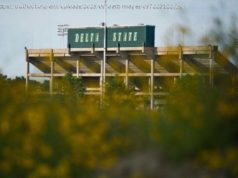The Cardinals’ offensive line is the problem, not the running backs, so adding Adrian Peterson might not provide much of a boost.
The idea that trading for Adrian Peterson will fix the Arizona Cardinals’ rushing woes is one eternal optimists will grasp onto and never let go.
Acquiring one of the best running backs in NFL history, in theory, would seem like an instant upgrade for a rushing attack that’s last in the NFL in total yards and yards per carry. However, the reality of the Cardinals’ ground game isn’t as rosy.
Arizona traded a 2018 conditional sixth-round draft pick to the Saints for RB Adrian Peterson on Tuesday. Read more
• Barnwell: Move worth the risk for Cards
• Cards’ O-line is problem, not the RBs
• Kamara’s breakout left no room for AD
• Stephen A. says Peterson is an upgrade
• Karabell: AD a viable fantasy option now?
• Cardinals release RB Chris Johnson
• What if AD had not chosen to be a RB?
• A look at AD’s contract with the Saints
It doesn’t matter who’s in Arizona’s backfield. The offensive line is the problem, not the running backs, so adding Peterson might not be the answer the Cardinals hope it’ll be.
The Cardinals’ offensive line has allowed the most sacks (13), most hits (21), most hurries (68) and most pressures (102) in the NFL this season. On average, NFL lines have allowed 53 pressures in 2017.
Arizona has rushed 100 times this season and gained 259 yards — an average of 2.59 yard per carry. The Cardinals ran for 31 yards Sunday in a blowout loss to the Philadelphia Eagles — for the game.
Coach Bruce Arians was quick to put the blame on the offensive line Sunday night, rather than on the running backs.
« It was mostly blocking, » he said.
That won’t change.
Not only has Arizona’s offensive line been riddled with injuries this season, the right side, consisting of first-year starter Evan Boehm at right guard and Jared Veldheer, who moved to right tackle from left tackle this season, has been inconsistent.
« The right side’s been struggling, » Arians said.
As a tandem, Veldheer and Boehm have allowed 42 pressures this season and eight hits; both are the most among right-side tandems in the NFL, according to Pro Football Focus. Together they’ve given up the second-most hurries (29) and sacks (five) among right-side duos.
In comparison, the average number of pressures allowed by right sides of offensive lines is 22, according to Pro Football Focus.
The injuries, however, have been the primary reason for Arizona’s ineffective running game.
Left tackle D. J. Humphries suffered a sprained MCL in Week 1 and hasn’t played since. Starting left guard Mike Iupati entered the season with an elbow injury, re-aggravated it in Week 1, missed the next two weeks and was placed on injured reserve Sept. 30.
In their places, Arizona turned to John Wetzel in place of Humphries and Alex Boone in place of Iupati in Weeks 2 and 3, Will Holden in place of Boone in Week 4 and Earl Watford in place of Holden in Week 5.
Arians praised center A. Q. Shipley as the lone offensive lineman who’s been consistent, saying Shipley has played « pretty solid. » Arians said Watford « didn’t play that bad » on Sunday and that « Wetzel’s been Wetzel — just plugs along and does a pretty decent job. »
The Cardinals have been rushing toward stability in the offensive line this season.
Of Arizona’s 259 rushing yards, 97 have come up the middle, 55 toward right guard and 48 outside of right tackle, according to ESPN Stats & Information, leaving just 59 yards toward the left side of the line.
However, the Cardinals could be getting Humphries and Boone back this week, Arians said, which would be more of an upgrade to a struggling run game at the moment.
« We’ll see, » Arians said. « But it looks like they’re going to have a chance. »
Darren Woodson breaks down what the Adrian Peterson trade means for the Cardinals and their running game.






